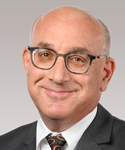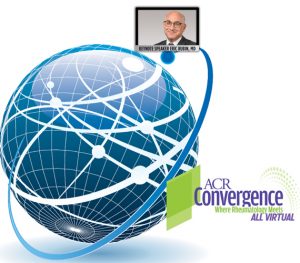Editor’s note: Registration for ACR Convergence 2020 is now open.
Less than a year after becoming editor in chief of The New England Journal of Medicine (NEJM), Eric Rubin, MD, PhD, found himself in the thick of the COVID-19 pandemic. SARS-CoV-2-related submissions flooded the journal office at an unprecedented pace, making an impact on the journal’s operations and giving him a new perspective on the importance of communication.
Dr. Rubin chairs the Harvard T.H. Chan School of Public Health’s Department of Immunology and Infectious Diseases, Boston. A recognized leader in infectious diseases, he is known for his groundbreaking tuberculosis research and his dedication to often neglected patient populations.
As the keynote speaker at ACR Convergence 2020 in November (which will be presented online via an entirely virtual format), Dr. Rubin will share his perspective on, and the importance of, communication during a pandemic.
The Impact of COVID-19
The Rheumatologist spoke with Dr. Rubin in late July about his experiences and what he plans to talk about in his keynote.
“At one point we were getting more than 200 COVID-19 articles, every day, seven days a week,” he says.
According to Dr. Rubin, the pandemic fueled an enormous volume of articles, stacking up more submissions in just a few months beginning in February than all of the previous year. Putting new systems in place to handle the unexpected spike in volume eventually calmed things down a bit, but the initial wave “felt overwhelming,” admits Dr. Rubin.
“We’re not a breaking news publication, but we had to get things out very quickly because a lot of what we published was only important if [it could be published in a timely manner] in the middle of the outbreak,” says Dr. Rubin.
That urgency put stress on the system, editors and staff, but it was nevertheless “a fascinating experience,” notes Dr. Rubin. Like the pandemic, the workload remained pretty much relentless as time marched on.
What to Expect
The variety of submissions Dr. Rubin and his staff received provided an abundance of material for his keynote speech, which will highlight various aspects of the COVID-19 pandemic. He expects to cover the status of vaccines under development to treat the virus and the most promising therapeutic trials, as well as the role of immunity in vaccines, convalescent plasma and interventions of inflammatory cascades.
“There’s a lot that’s of particular interest to rheumatologists because COVID-19 is an infection, but it’s an infection that triggers an inflammatory cascade,” says Dr. Rubin. “It turns out that some of our most effective therapies are likely directed against host inflammation, which are the same drugs we use for rheumatologic diseases.
“So the illness is sort of on the cusp between infectious disease and rheumatology. In fact, when I was seeing patients in the hospital last month, we had both an infectious disease specialist and a rheumatologist advising each one of the teams.”
Given the fluid nature of the pandemic, expect key highlights to include a timely look at virus concerns current in November when the ACR event will be held, in addition to Dr. Rubin’s insights into how the virus hit at a time of great change in the medical journal industry.
Being in the medical communication business means accepting that stand-alone journals aren’t likely to last forever. In today’s world, medical professionals—like everyone else—get information in many forms strikingly different from how they have in the past, notes Dr. Rubin.
“We have to really be future-proofing ourselves,” he says. “How are we going to have the same sort of impact that we have now in a world where people don’t have time to read articles, are used to seeing things on their phones and engage information in very different ways? We’re thinking about that.”
The emergence of medical journal preprints that have not been peer reviewed is relatively new and picked up steam within the last year, says Dr. Rubin. It raises the question of whether evaluating these submissions in the traditional way is even possible or practical.
“We’ve seen examples of [preprints] working well and plenty of examples of it not working well,” he says. “I think it’s going to take a little bit of time to digest the messages in that, but clearly we have a lot of material to look at right now.”
Continuing Research
Before taking the helm at the NEJM in September 2019, Dr. Rubin worked part-time as an associate editor at the journal and thoroughly enjoyed it. He still loves the work as much as his other jobs as a scientist and a physician.
He spends at least a day each week working in his lab at Harvard T.H. Chan School of Public Health and meeting with graduate students and post-doctoral fellows. He says he agreed to take the editor job provided he didn’t have to give up his research.
Dr. Rubin’s interest in medicine began when he was a boy. His father, who didn’t go to college, often told him, “[you’re] going to become a doctor. So I grew up thinking, ‘Oh, I have to be a doctor.’” He followed this path, also pursuing his love of science by becoming a laboratory scientist.
Serving as the NEJM editor in chief is an amazing job, says Dr. Rubin. He reads every submission and interacts with all manuscripts through each step along the road to publication. “It’s all the best articles in medicine being presented in detail by an expert in the area,” he says.
Once a week, Dr. Rubin gets together with all of the editors to review submissions that have a chance of being published in the journal. They discuss each one in terms of truth, importance, ethics and “whether or not if we publish it, the conclusion will cause doctors to do the right thing or do the wrong thing.” This hashing out has “import for what happens to a patient,” he says.
“It’s absolutely fascinating,” says Dr. Rubin. “It’s the best journal club in all of medicine. I really, really enjoy it.”
About ACR Convergence 2020
The ACR recognizes the incredible challenges this year has presented and that it may be difficult to channel your energy into other topics. But focusing on the future will help keep us moving forward. ACR Convergence 2020 (the new name for the ACR’s annual meeting) will be our first fully virtual annual meeting, taking place Nov. 5–9, in which the global rheumatology community can collaborate, innovate and learn. Get the details at https://www.rheumatology.org/Annual-Meeting.
Catherine Kolonko is a medical writer based in Oregon.




